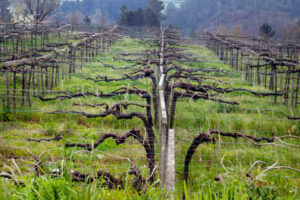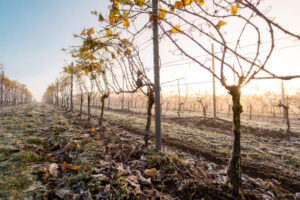Winterization: How to Organize Vineyard Maintenance Tasks Leading Into Your Next Harvest Season

Once the harvest is complete, winemakers must begin preparing their vines and vineyards for dormancy.
Through Bryan Christiansen
The vineyard cycle is broken down into 6 distinct phases throughout the year, each of which is critical to the success of the grape growing cycle. The first five stages conclude with the annual grape harvest, when the vines enter the sixth stage: hibernation. How the vines are tended during the winter season is crucial to the success of the next vintage.
Once the harvest is complete, winemakers must begin preparing their vines and vineyards for dormancy. The time between the end of the harvest and the first frost is critical for the grapes and the list of important tasks is long.

Although the vines appear to be asleep, they are most certainly not. A lot of microscopic activity takes place during their dormant phase, with the vines and their roots both being active beneath their bark.
compost and cover crops
It is important to protect not only the vines but also the soil in the rows of vineyards as the harsh elements of winter storms and the potential erosion of the soil covering the plant roots are both major threats during the winter months.
Shelter is often achieved by planting a cover crop such as clover or native grasses that will hold the soil firmly together. Straw and compost can also be used to protect the soil; Compost serves a dual purpose as it protects the soil and provides vital nutrients that are slowly absorbed.
It is important to ensure that the vines are not fertilized too late in the season as fertilizer encourages the growth of lush green tissue. Running this process too late can damage growth and lead to other problems such as plant stress and pest infestations.
pruning and vine health
The pruning season varies from vineyard to vineyard as the climate and location of the vineyard determine when work can begin.
The pruning usually takes place between December and March. Each vine is carefully examined to see if it was strong the previous year and if it may have diseases – such as the wood fungus Eutypa, which can be caused by too much rainwater on fresh cuts from the vine.

Pruning also ensures consistency in grape production and allows for proper vineyard management. Pruning techniques vary by grape variety, and the vigneron and his crew select one or more buds to keep for the coming year.
The pruning process determines the following year’s harvest, even before the vine emerges from the dormant phase. Depending on the size of the vineyards, pruning can take a few weeks or a few months.
Replanting dead and damaged vines
Various factors – diseases, harsh weather, wild animals and old age – can lead to damage and destruction of vines. The average lifespan of a vine is 25 years; However, some vines can live for over 100 years.
In the meantime, it is important to ensure the continuity of the vineyard and to keep the rows of vineyards as complete as possible. Newly planted vines can take at least three years to produce viable grapes, meaning new plants can reduce the overall production of the vineyards.

Her vineyard crew identify severely damaged, diseased, and dead plants throughout the year and mark them for removal. These vines should be replaced with new plants after the last hard frost of the year and should not be fertilized in the first year of growth.
Working on the irrigation system
After the harvest is complete, the irrigation system must be shut down to allow the vines to acclimate to the arrival of cooler temperatures and lower light levels. If the vines have tubing around their trunk (often used to protect the trunk from damage from herbicides, sun damage, and accelerated plant growth), these must be removed.
During the day, the tubes create a small microclimate that is hotter than the outside temperature. At night, however, the temperature is the same as outside the tube – these extreme temperature fluctuations can potentially damage the vines and make the transition to hibernation more difficult.
Equipment repairs and building maintenance
During the busy growing and harvesting season, there is little time to focus on other activities required around the winery. The slower winter season is a good time to check the integrity of your structures and equipment to ensure everything is in order and ready for the next growing season. Implementing maintenance software is one way to ensure you don’t miss important tasks.
Running a successful winery requires constant attention from the vineyard and winery teams throughout the year, and the tasks carried out during the winter months are key to ensuring that the next harvest will be successful.
__________________________________________________________________________
 Bryan Christiansen
Bryan Christiansen
Bryan Christiansen is the founder and CEO of Flexible CMMS. Limble is a modern, easy-to-use mobile CMMS software that takes the stress and chaos out of maintenance by helping managers organize, automate, and streamline their maintenance operations.
